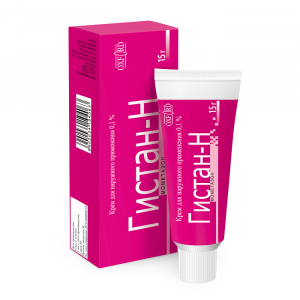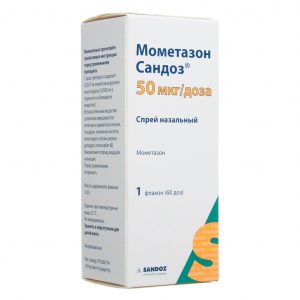Description
Pharmacological action
Pharmacodynamics
Non-sedating antihistamine, long-acting. It is the primary active metabolite of loratadine. Selectively blocks the activity of peripheral H histamine receptors.
Suppresses the release of histamine from mast cells. It inhibits a cascade of allergic inflammation reactions, including the release of anti-inflammatory cytokines, including interleukins IL-4, IL-6, IL-8, IL-13, and the release of adhesion molecules such as P-selectin. Thus, it prevents the development and facilitates the course of allergic reactions, has an antipruritic and antiexudative effect, reduces capillary permeability, prevents the development of tissue edema, smooth muscle spasm.
The drug does not affect the central nervous system, practically does not have a sedative effect (does not cause drowsiness) and does not affect the speed of psychomotor reactions. Does not cause prolongation of the QT interval on the ECG.
Pharmacokinetics
Absorption
After oral administration, desloratadine is well absorbed in the gastrointestinal tract, determined in blood plasma 30 minutes after oral administration. The maximum concentration of Cmax is reached after about 3 hours.
Distribution of
The binding of desloratadine to plasma proteins is 83-87%. When used in adults and adolescents for 14 days at a dose of 5 mg to 20 mg once a day, no clinically significant cumulation of desloratadine was detected. The simultaneous ingestion of food or grapefruit juice does not affect the distribution of desloratadine (when taken in a dose of 7.5 mg once a day). Does not cross the blood-brain barrier.
Metabolism
Undergoes extensive metabolism in the liver by hydroxylation to form 3-OH-desloratadine coupled to glucuronide. It is not an inhibitor of CYP3A4 and CYP2D6 isoenzymes and is not a substrate or an inhibitor of P-glycoprotein.
Excretion
Desloratadine is excreted in the form of a glucuronide compound and in a small amount (less than 2%) by the kidneys and through the intestines (less than 7%) unchanged. The half-life of T averages 27 hours
Indications
Allergic rhinitis (elimination or relief of sneezing, nasal congestion, mucus discharge from the nose, itching in the nose, itching of the palate, itching and redness of the eyes, lacrimation)
urticaria (reduction or elimination of skin itching, rash).
Contraindications
Hypersensitivity to the drug components pregnancy and lactation age up to 12 years phenylketonuria.
With caution
In the presence of severe renal failure, the drug should be taken with caution.
Special instructions
Effect on the ability to drive vehicles and mechanisms
At the recommended dose, the drug does not affect the ability to drive vehicles or mechanisms.
However, in very rare cases, some patients may experience drowsiness while taking desloratadine, which may affect their ability to drive vehicles or operate machinery.
Composition of
One lozenge tablet contains:
active substance:
desloratadine 5 mg
excipients:
mannitol – 133.5 mg,
microcrystalline cellulose – 15.0 mg,
croscarclosa sodium, 6.0 mg crocrystellose potassium – 5.0 mg,
aspartame – 3.0 mg,
magnesium stearate – 1.7 mg,
tutti-frutti flavoring (flavoring agents, maltodextrin, propylene glycol E1520, modified starch E1450) – 0.75 mg, iron dye red oxide – 0.7 mg,
citric acid monohydrate – qs
Dosage and administration
Inside, regardless of food intake. It is necessary to carefully open the blister and take out the tablet without breaking it. A resorption tablet is placed on the tongue, where it dissolves, after which it is swallowed with saliva, not washed down with water or other liquid. The tablet should be taken immediately after opening the blister.
Adults and adolescents over 12 years of age: 1 tablet for resorption (5 mg) once a day to reduce the symptoms of allergic rhinitis (including seasonal and year-round allergic rhinitis) and urticaria.
In seasonal (intermittent) allergic rhinitis (in the presence of symptoms lasting less than 4 days a week or less than 4 weeks a year), the course of the disease must be assessed. If the symptoms disappear, the drug should be discontinued, when symptoms reappear, the drug should be resumed.
In case of year-round (persistent) allergic rhinitis (in the presence of symptoms lasting more than 4 days a week or more than 4 weeks a year), the drug should be taken during the entire period of exposure to the allergen.
Side effects
The frequency of adverse reactions is classified according to the recommendations of the World Health Organization: very often – at least 10% often – at least 1%, but less than 10% infrequently – at least 0.1%, but less than 1% rarely – at least 0.01%, but less than 0.1% very rarely – less than 0.01%, including individual messages.
The most common adverse effects (> 1/100 to <1/10): fatigue, dry mouth and headache. Very rarely (<1/10 000) the following undesirable effects were noted: From the central nervous system: hallucinations, dizziness, drowsiness, insomnia, psychomotor hyperactivity, convulsions. From the cardiovascular system: tachycardia, palpitations. From the digestive system: abdominal pain, nausea, vomiting, dyspepsia, diarrhea. From the liver and biliary tract: increased activity of hepatic transaminases, increased bilirubin concentration, hepatitis. From the musculoskeletal system: myalgia. On the part of the immune system: anaphylaxis, angioedema, dyspnea, itching, rash, including urticaria, photosensitivity. If any of the side effects indicated in the instructions are aggravated, or you notice any other side effects not listed in the instructions, inform your doctor. Overdose of In clinical trials with the use of desloratadine in a dose of up to 45 mg (9 times the therapeutic dose), no clinically significant adverse effects were observed. Treatment: In case of overdose, standard measures are taken to remove the active substance from the gastrointestinal tract. Symptomatic and supportive therapy is recommended. Desloratadine is not excreted during hemodialysis, the effectiveness of peritoneal dialysis has not been established. Storage conditions At a temperature not exceeding 25 ° C. Keep out of the reach of children! Expiration 3 years. Terms and conditions without prescription Appointment Adult, Children over 12 years Indications dermatitis Pollynoz, Krapyvnytsa, Nasmork, conjunctivitis, Allerhyya




